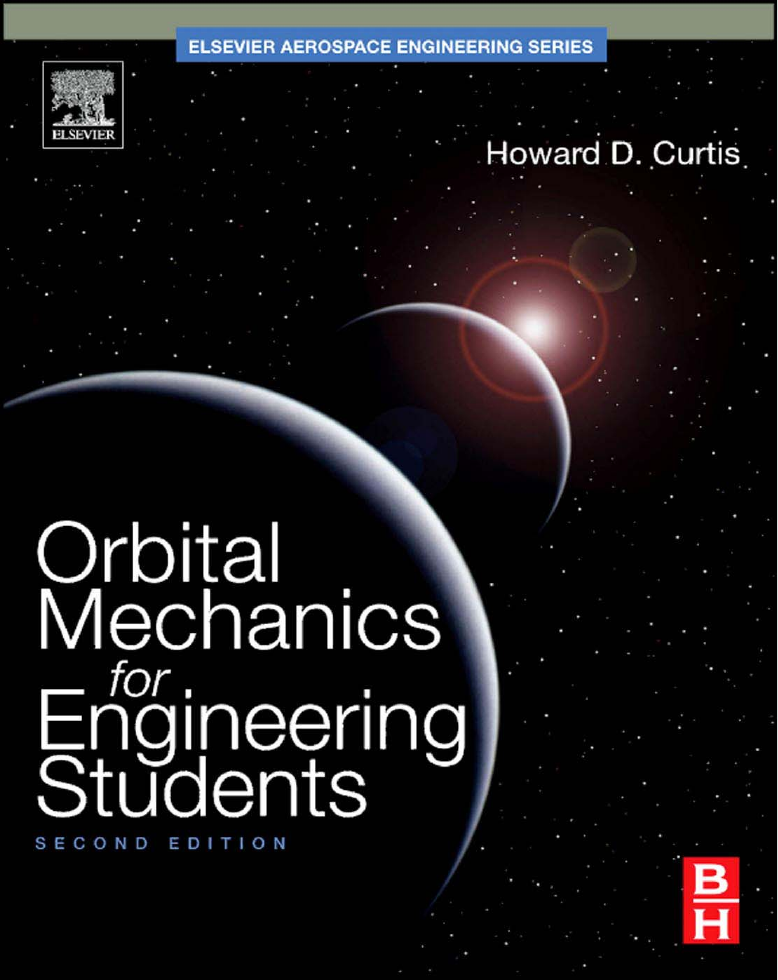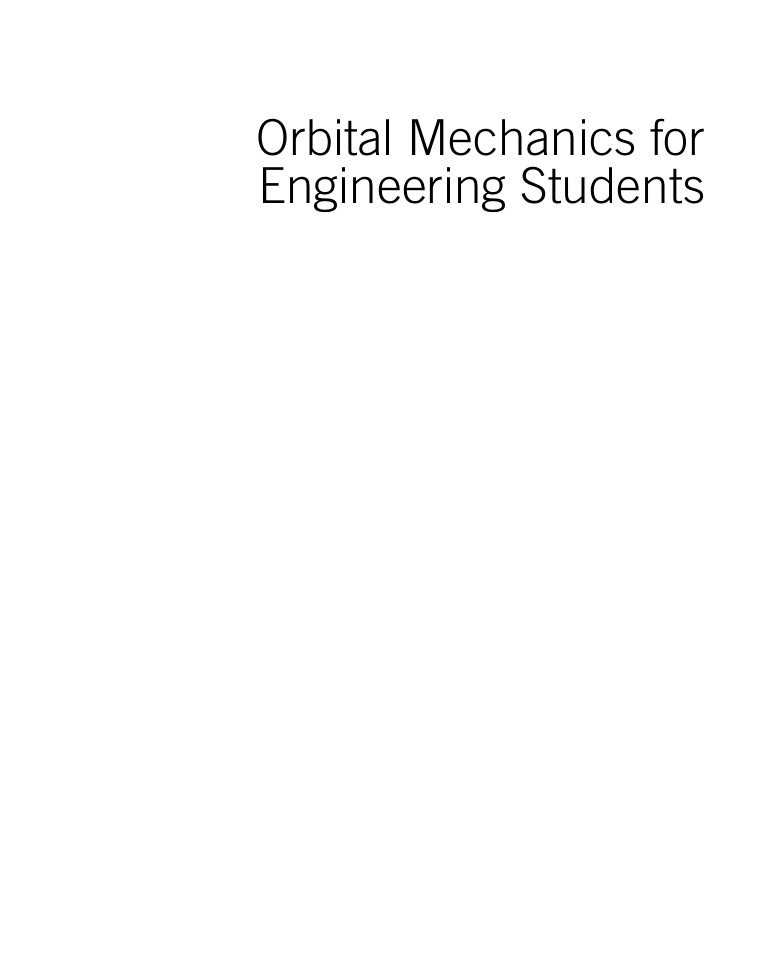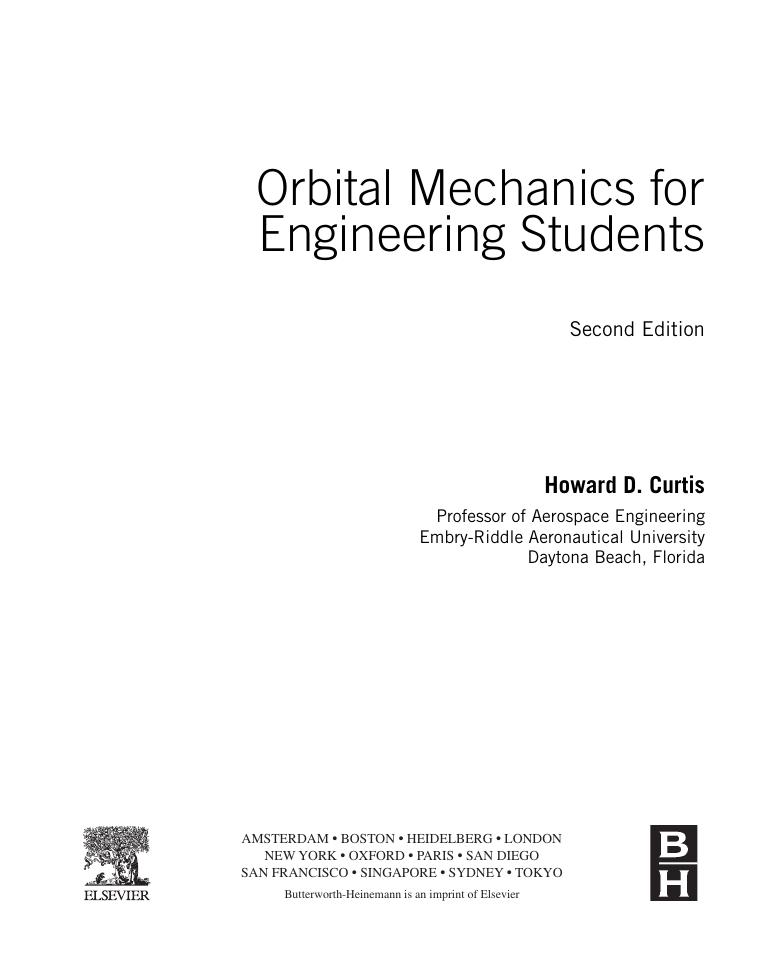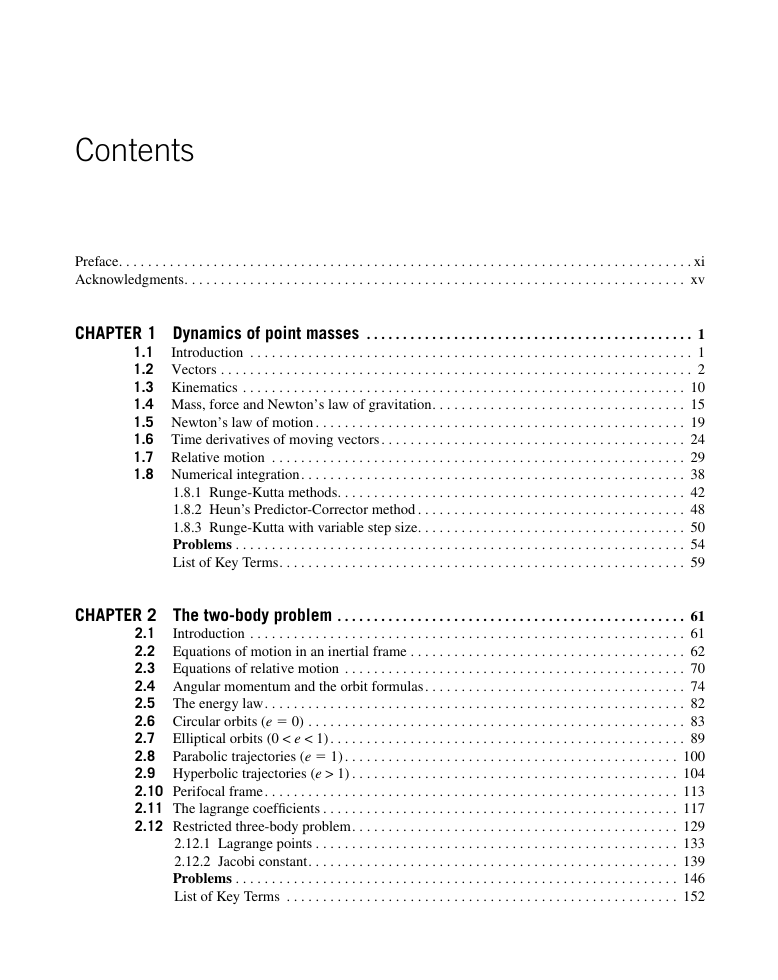cover
title page
copyright page
contents
preface
acknowledgments
CHAPTER 1 Dynamics of point masses
1.1 Introduction
1.2 Vectors
1.3 Kinematics
1.4 Mass, force and Newton's law of gravitation
1.5 Newton's law of motion
1.6 Time derivatives of moving vectors
1.7 Relative motion
1.8 Numerical integration
1.8.1 Runge-Kutta methods
1.8.2 Heun's Predictor-Corrector method
1.8.3 Runge-Kutta with variable step size
Problems
List of Key Terms
CHAPTER 2 The two-body problem
2.1 Introduction
2.2 Equations of motion in an inertial frame
2.3 Equations of relative motion
2.4 Angular momentum and the orbit formulas
2.5 The energy law
2.6 Circular orbits (e = 0)
2.7 Elliptical orbits (0 < e < 1)
2.8 Parabolic trajectories (e = 1)
2.9 Hyperbolic trajectories (e > 1)
2.10 Perifocal frame
2.11 The lagrange coefficients
2.12 Restricted three-body problem
2.12.1 Lagrange points
2.12.2 Jacobi constant
Problems
List of Key Terms
CHAPTER 3 Orbital position as a function of time
3.1 Introduction
3.2 Time since periapsis
3.3 Circular orbits (e = 0)
3.4 Elliptical orbits (e < 1)
3.5 Parabolic trajectories (e = 1)
3.6 Hyperbolic trajectories (e < 1)
3.7 Universal variables
Problems
List of Key Terms
CHAPTER 4 Orbits in three dimensions
4.1 Introduction
4.2 Geocentric right ascension-declination frame
4.3 State vector and the geocentric equatorial frame
4.4 Orbital elements and the state vector
4.5 Coordinate transformation
4.6 Transformation between geocentric equatorial and perifocal frames
4.7 Effects of the Earth's oblateness
4.8 Ground tracks
Problems
List of Key Terms
CHAPTER 5 Preliminary orbit determination
5.1 Introduction
5.2 Gibbs method of orbit determination from three position vectors
5.3 Lambert's problem
5.4 Sidereal time
5.5 Topocentric coordinate system
5.6 Topocentric equatorial coordinate system
5.7 Topocentric horizon coordinate system
5.8 Orbit determination from angle and range measurements
5.9 Angles only preliminary orbit determination
5.10 Gauss method of preliminary orbit determination
Problems
List of Key Terms
CHAPTER 6 Orbital maneuvers
6.1 Introduction
6.2 Impulsive maneuvers
6.3 Hohmann transfer
6.4 Bi-elliptic Hohmann transfer
6.5 Phasing maneuvers
6.6 Non-Hohmann transfers with a common apse line
6.7 Apse line rotation
6.8 Chase maneuvers
6.9 Plane change maneuvers
6.10 Nonimpulsive orbital maneuvers
Problems
List of Key Terms
CHAPTER 7 Relative motion and rendezvous
7.1 Introduction
7.2 Relative motion in orbit
7.3 Linearization of the equations of relative motion in orbit
7.4 Clohessy-Wiltshire equations
7.5 Two-impulse rendezvous maneuvers
7.6 Relative motion in close-proximity circular orbits
Problems
List of Key Terms
CHAPTER 8 Interplanetary trajectories
8.1 Introduction
8.2 Interplanetary Hohmann transfers
8.3 Rendezvous Opportunities
8.4 Sphere of influence
8.5 Method of patched conics
8.6 Planetary departure
8.7 Sensitivity analysis
8.8 Planetary rendezvous
8.9 Planetary flyby
8.10 Planetary ephemeris
8.11 Non-Hohmann interplanetary trajectories
Problems
List of Key Terms
CHAPTER 9 Rigid-body dynamics
9.1 Introduction
9.2 Kinematics
9.3 Equations of translational motion
9.4 Equations of rotational motion
9.5 Moments of inertia
9.5.1 Parallel axis theorem
9.6 Euler's equations
9.7 Kinetic energy
9.8 The spinning top
9.9 Euler angles
9.10 Yaw, pitch and roll angles
9.11 Quaternions
Problems
List of Key Terms
CHAPTER 10 Satellite attitude dynamics
10.1 Introduction
10.2 Torque-free motion
10.3 Stability of torque-free motion
10.4 Dual-spin spacecraft
10.5 Nutation damper
10.6 Coning maneuver
10.7 Attitude control thrusters
10.8 Yo-yo despin mechanism
10.8.1 Radial release
10.9 Gyroscopic attitude control
10.10 Gravity gradient stabilization
Problems
List of Key Terms
CHAPTER 11 Rocket vehicle dynamics
11.1 Introduction
11.2 Equations of motion
11.3 The thrust equation
11.4 Rocket performance
11.5 Restricted staging in field-free space
11.6 Optimal staging
11.6.1 Lagrange multiplier
Problems
List of Key Terms
Appendix A Physical data
Appendix B A road map
Appendix C Numerical intergration of the n-body equations of motion
Appendix D MATLAB® algorithms
Appendix E Gravitational potential energy of a sphere
References
Index
A
B
C
D
E
F
G
H
I
J
K
L
M
N
O
P
Q
R
S
T
U
V
W
Y
Z
















 2023年江西萍乡中考道德与法治真题及答案.doc
2023年江西萍乡中考道德与法治真题及答案.doc 2012年重庆南川中考生物真题及答案.doc
2012年重庆南川中考生物真题及答案.doc 2013年江西师范大学地理学综合及文艺理论基础考研真题.doc
2013年江西师范大学地理学综合及文艺理论基础考研真题.doc 2020年四川甘孜小升初语文真题及答案I卷.doc
2020年四川甘孜小升初语文真题及答案I卷.doc 2020年注册岩土工程师专业基础考试真题及答案.doc
2020年注册岩土工程师专业基础考试真题及答案.doc 2023-2024学年福建省厦门市九年级上学期数学月考试题及答案.doc
2023-2024学年福建省厦门市九年级上学期数学月考试题及答案.doc 2021-2022学年辽宁省沈阳市大东区九年级上学期语文期末试题及答案.doc
2021-2022学年辽宁省沈阳市大东区九年级上学期语文期末试题及答案.doc 2022-2023学年北京东城区初三第一学期物理期末试卷及答案.doc
2022-2023学年北京东城区初三第一学期物理期末试卷及答案.doc 2018上半年江西教师资格初中地理学科知识与教学能力真题及答案.doc
2018上半年江西教师资格初中地理学科知识与教学能力真题及答案.doc 2012年河北国家公务员申论考试真题及答案-省级.doc
2012年河北国家公务员申论考试真题及答案-省级.doc 2020-2021学年江苏省扬州市江都区邵樊片九年级上学期数学第一次质量检测试题及答案.doc
2020-2021学年江苏省扬州市江都区邵樊片九年级上学期数学第一次质量检测试题及答案.doc 2022下半年黑龙江教师资格证中学综合素质真题及答案.doc
2022下半年黑龙江教师资格证中学综合素质真题及答案.doc